Jerome Frescobaldi facts for kids
Jerome, Hieronimo, or Girolamo Frescobaldi (died 1517) was a successful Italian businessman. He was a financier (someone who manages large amounts of money) and a textile merchant (someone who sells fabrics). He lived in Bruges, a busy trading city in what is now Belgium.
Jerome supplied fancy goods to the Scottish royal family, including King James IV and Queen Margaret Tudor. He was known as a "very good friend to the King of Scots." His family and company, based in Florence, Italy, were also involved in art projects in England and Scotland. Jerome Frescobaldi also traded wool and spices.
Contents
Life in Bruges
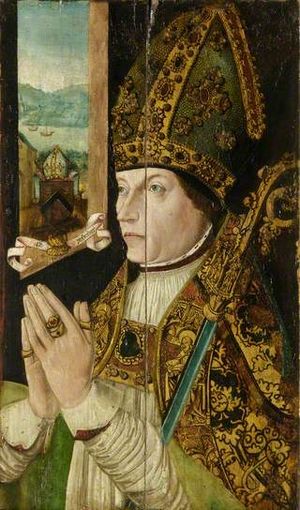
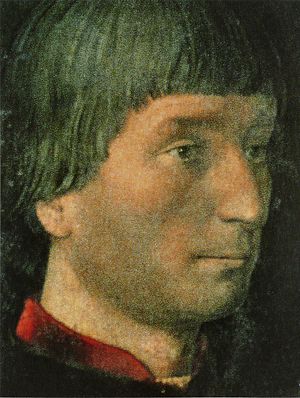
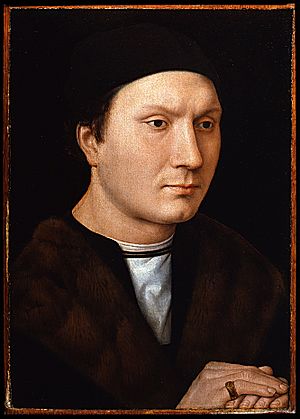
Jerome Frescobaldi was part of the famous Frescobaldi family from Florence, Italy. They were very successful in international trade. In Scottish records, he was sometimes called a "Lombard," which was a general term for Italian merchants.
Jerome and his business partners, the Gualterotti family, helped fund a trip for Giovanni da Empoli. He traveled from Lisbon to India in 1503-1504. Their goal was for him to buy spices in Calicut, India, for their business.
Jerome Frescobaldi mostly lived in Bruges. Records show his business deals from 1475 onwards. He worked with the Company of Bruges, trading wool and dealing with the Portinari family, who were bankers for the powerful House of Medici. In 1493, he and Antonio Gualterotti bought property near Tommaso Portinari.
By 1498, Jerome Frescobaldi was listed as the top Italian businessman in Bruges. He was followed by other important bankers and merchants.
In 1507, he opened a trading office in Antwerp to get more loans and credit. He had often visited Antwerp in the years before this. He was even the Florentine consul (a representative for his home city) in Antwerp in 1500. He also did business with Andrew Halyburton, a Scottish merchant, whose records show their deals from 1497.
Working for Royalty
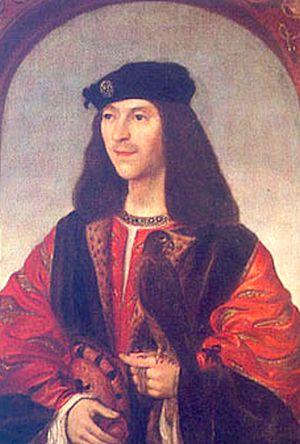
Frescobaldi worked for King James IV of Scotland and his wife, Queen Margaret Tudor. His name appears many times in the royal financial records. He helped Scottish church leaders get money when they traveled in Europe. He also managed the foreign debts for the Archbishop of St Andrews.
He supplied beautiful fabrics for clothes, furniture, and table linens. He worked with James Merchamestoun, a Scottish merchant, to import goods from Bruges. In 1503, Merchamestoun bought silver items and special chairs for the king's marriage to Margaret Tudor. Frescobaldi helped finance these purchases with William Elphinstone, the Bishop of Aberdeen.
Another Scottish merchant, James Hommyll, bought tapestries in Flanders for the king. He also hosted a group of Africans, including a woman named Ellen More, at his house in Edinburgh.
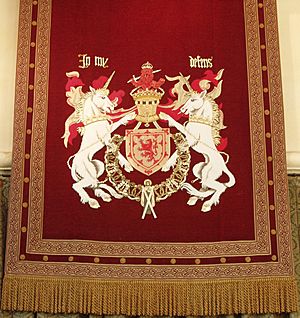
In May 1503, Jerome's assistant, Julian Laci (also called "Julian the Lombard"), was paid for things bought in Flanders. These included ermine fur for the king's gown, five fancy chairs covered in gold fabric, velvet for four other chairs, and iron parts for the chairs. They also bought 16 gilded pewter balls for the chairs. The chairs were made in Bruges and shipped from Middelburg. Julian Laci was also allowed to avoid paying export taxes on wool from Melrose Abbey. In May 1505, Julian Laci met with the Edinburgh city council. He signed a paper saying that a former leader of Edinburgh had returned all of Frescobaldi's goods.
From 1505 to 1507, Jerome Frescobaldi organized many purchases for King James IV using Flemish money. These included gold fabric, gold thread, money for large horses, gold leaf for decorating books, and live quails and pheasants. He gave money to the king's messengers and arranged for 1,000 gold coins to be available in Venice for the king's son, Alexander Stewart, who was also an Archbishop. He also arranged payments for important church documents and later for the promotion of Gavin Douglas to a high church position in 1516.
The gold fabric was used to make a coat for King James IV. The rest was given to Queen Margaret Tudor. This expensive gold fabric was used with velvet to make an important gown for the Queen in March 1507. Historians believe this gown was for a special ceremony after her first pregnancy. Some of the gold thread was sent to Margaret Tudor when she was on a religious trip in June 1507.
Frescobaldi and Julian Laci were not always in Scotland. A note from 1504 shows that the court embroiderer used gold thread from Frescobaldi for a special church robe. However, no one was there to say how much it cost.
Frescobaldi also did business with William Todrik, an Edinburgh merchant. After Todrik died, Frescobaldi gave money to his family. Todrik used to export wool to Flanders.
Frescobaldi Family in England
Jerome Frescobaldi supplied some fabrics for the coronation of King Henry VII of England in 1485. His sons, Filippo and Leonard Frescobaldi, continued this business at the English court from 1511. Many other Italian merchants lived there too. In 1516, King Henry VIII gave Leonard Frescobaldi a regular payment because he sold gold and silver fabrics. Leonard also became an usher (an official who guides people) in the king's room. Leonard helped guarantee a contract for an artist to make a tomb for Lady Margaret Beaufort, Henry VIII's grandmother.
Leonard Frescobaldi also supplied gold thread to the king's embroiderer. He even supplied weapons and military gear to Henry VIII. This included axes, handguns, 4,500 suits of armor, ropes for ships, and a set of twelve cannons called the "Twelve Apostles." Some of these weapons might have been used in battles in France and against Scotland at the Battle of Flodden. A powerful church leader, Cardinal Wolsey, helped get loans from the Frescobaldi and Cavalcanti banks to pay for Henry VIII's armor and cannons.
It is said that Jerome's son Francesco Frescobaldi offered a place to stay and work for Thomas Cromwell in Florence around 1504. Thomas Cromwell later became a very important advisor to King Henry VIII.
Frescobaldi and Alum Trade
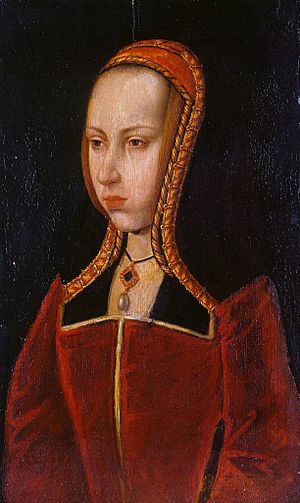
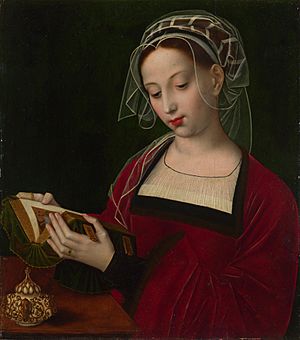
Pope Julius II wanted to control the trade of alum to increase his income. Alum was a very important mineral used in tanning leather and dyeing cloth. In 1506, Frescobaldi's business in Bruges was criticized for importing Turkish alum. This made alum cheaper and broke the Pope's control over the trade.
When King James IV heard that Pope Julius II was upset with Frescobaldi, he wrote to the Pope in February 1508 to support his friend. James IV explained that Frescobaldi had been involved in the alum trade because Philip I of Castile had pressured him to import it. James IV called Frescobaldi his "good friend and close associate." He also wrote to the King of France, Louis XII, hoping he would help Frescobaldi too.
Margaret of Austria, Duchess of Savoy, who governed the Netherlands, also supported Frescobaldi. King Henry VII of England also agreed with Frescobaldi's role in the alum trade. He argued that the Pope needed their support for a new religious war. King James IV was also keen on the idea of a religious war against Turkish ships in the Mediterranean Sea.
Scottish Trade to 1513
In 1508, Frescobaldi sent more gold fabric to Scotland. He also arranged for some of the royal tapestries to be fixed after they were damaged in a fire. The fire also harmed some of Queen Margaret Tudor's clothes.
Frescobaldi helped pay for the ropes and equipment for a ship bought in Flanders. Some of the fabric he sent to Scotland was used by the king's tailor to make flags for the king's ships, including a ship called the Margaret.
In 1510, King James IV wrote to King Louis XII of France to support Frescobaldi. This was because there were bad rumors about Frescobaldi at the Pope's court.
Other Italians at the Scottish court around this time included a stone mason named Cressent and a priest and alchemist named John Damian. In March 1513, James IV gave a license to a Florentine merchant named "Lactente" Altoviti to trade in Scotland.
In 1513, the Bishop of Caithness, who managed the royal households, sent barrels of salmon to Frescobaldi. These were allowed to be sent without paying customs duty. Frescobaldi is mentioned as a supplier in the royal household's account book.
Death and Legacy
Jerome Frescobaldi died in 1517. In May 1518, his five sons – Leonard, Francesco, Jehan, Pierre, and Philippe – took over his business in Bruges. However, their business in Antwerp failed that same year. With help from important church leaders, his sons were able to restart the business as Leonard Frescobaldi and Company.
Artistic Connections
Frescobaldi lent money to Margaret of Austria, Duchess of Savoy, who governed the Netherlands. She used some of her jeweled tableware as a guarantee for the loan. Frescobaldi returned the tableware to her. A goldsmith named Lieven van Lathem weighed and valued the pieces.
Frescobaldi also supplied art materials to the Scottish court. In 1508, colors for painting sent from Flanders cost a large sum of money. These might have been for a painter called "Piers" in the records. Piers might have been Peerken Bovelant, an apprentice of a painter in Antwerp.
Piers was brought to Scotland in September 1505 by Andrew Halyburton, a Scottish trading agent. We don't know much about Piers's work, but he helped paint costumes and symbols for royal events. He used gold leaf provided by James Homyll. Piers also cut out letters to decorate the king's horses' armor using velvet and gold fabric from Frescobaldi. The king paid him a salary and gave him a place to live. It is likely that Piers painted portraits for the court. A portrait of James IV from 1507 still exists today. Piers returned to Flanders in July 1508.
Frescobaldi's family also had artistic connections in the Netherlands. In 1530, the painter Ambrosius Benson and a Spanish pharmacist were chosen to manage the affairs of Frescobaldi's daughter, Johanna or Jennette Frescobaldi. She married Guyot de Beaugrant, a sculptor from Lorraine. He worked for Margaret of Austria in Brussels and carved a famous story on a fireplace in Bruges. They moved to Spain in 1533.

